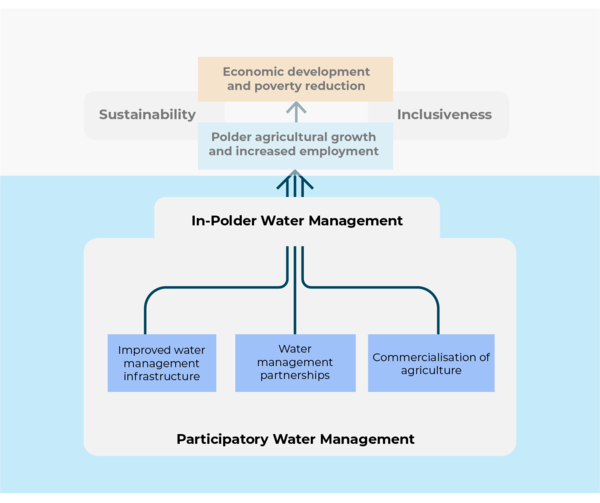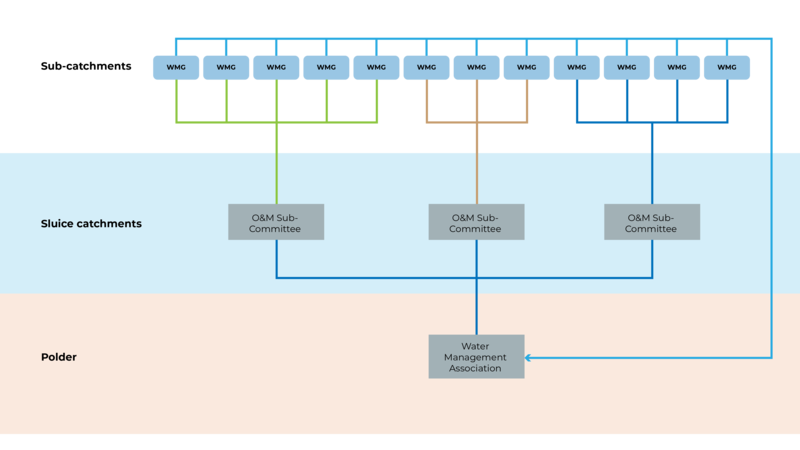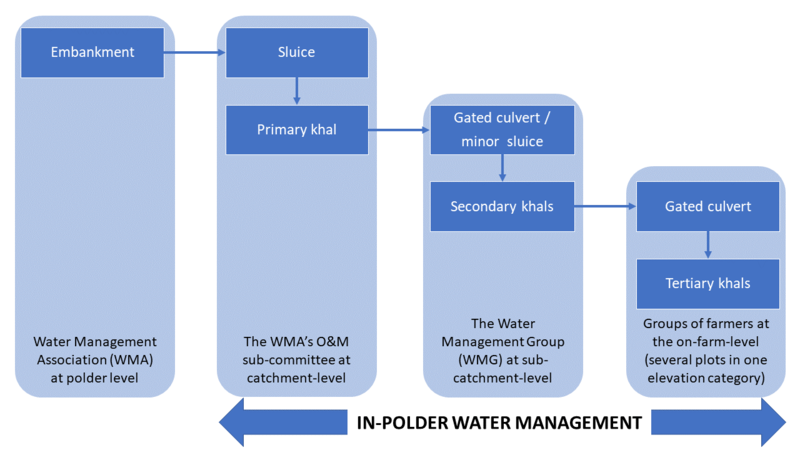Views
Actions
Summary of Section D: BGP Interventions: Participatory Water Management
Participatory Water Management (PWM) in BGP comprises a set of activities that aims to utilise water infrastructure for transforming agriculture in the coastal polders; and which thereby forms the central driver for intensified local economic development in the project area. The PWM activities includes: consultation of communities; capacity building of water management organisations; addressing gender dimensions of water management; physical in-polder water management interventions); and development of a water management partnership.
Under Blue Gold, a unified approach towards Participatory Water Management was developed. This approach was documented in February 2017 in the form of a PWM Field Manual (in English and Bangla). Alongside the distribution of the manual, dedicated training in the unified approach was provided to all Community Development Facilitators (CDFs) in December 2016 and January 2017. A vivid testimony on the implementation of this approach in Polder 47/4 in Kalapara is presented in a paper prepared on behalf of the CDFs by colleagues at zonal level.
Through Blue Gold, O&M Agreements (in Bangla and an unofficial English translation) have been used to set out the respective responsibilities of BWDB and WMAs for routine, periodic and emergency maintenance. The main purpose of the agreements is to sustain the benefits arising from bringing land into cultivation – to protect the land from further waterlogging and to bring new land into cultivation. O&M agreements have been signed by the BWDB Executive Engineer with representatives of the Executive Councils for the 36 WMAs in the Blue Gold Program area.
To encourage good practice in water management, two versions of a manual for WMO executive members and BWDB field staff were prepared: a ‘text-based’ manual (in Bangla) for a more literate audience; and a ‘picture-based’ manual (again in Bangla) for an audience that is less familiar with text-based advice. During preparation of the manuals, Blue Gold worked closely with field staff, WMO executives and other WMO members and incorporated their feedback to ensure that the manuals serve the needs and interests of farmers and fishermen. Feedback sessions with BWDB zonal staff have been used to establish that all required material is covered. Copies of the manuals were distributed to WMOs during the first quarter of 2021.
The key message of this section is that presently, Bangladesh does not use the full potential of participatory water management for engendering local economic development. Infrastructure development and agricultural development are generally undertaken as separate interventions, often under a strong central coordination; while the capability of local stakeholders to utilise water resources and associate infrastructure for a dynamic development of agriculture goes largely ignored. In addition to reviewing the PWM activities listed above, this section also looks at how BGP operationalised the PWM concept and it concludes with a section on a way forward for participatory water management to become the glue that welds water resources infrastructure and local agricultural-based development together.
Consultation and participation in planning[edit | edit source]
BGP, at its inception, addressed community consultation and participation in planning through a Polder Development Plan and local-level WMG Action Plans. Several lessons are drawn:
- Consultation of communities and their representatives is more meaningful if it starts well before the definition of infrastructure investments in implementation budgets
- Local governments and representatives of decentralised departments are relevant and constructive partners in local water resources planning
- Facilitated community planning should be complemented with coaching of community actions, e.g. for better agricultural production. A little encouragement helps people undertake the actions that they have planned for.
- Periodic review and adjustment is required to arrive at realistic ambitions, possibly in terms of higher productivity or profitability, and coherent and do-able actions.
Using these insights, BGP in the second half of its implementation period, linked local water management plans to catchment plans and subsequently to polder-level WMA plans. The ensuing plans focus on water management actions at different levels of the polder water system (see: In-Polder Water Management).
WMO capacity building[edit | edit source]
BGP helped activate 511 water management groups and 36 water management associations in 22 polders. In order to help these organisations to work for better water management, BGP applied the following principles in building their capacity:
- Build capacities of groups and teams
- Support both planning and implementation
- Let WMOs take the lead in implementing actions
- Promote WMOs to use their local network for achieving their aspirations.
Women’s participation in water management[edit | edit source]
While the regulatory framework sets quota for women’s participation in WMOs, BGP explicitly pursued that women in and above this quota would participate in an active and significant way. This resulted in women taking part with voice and vote in WMO meetings; in a significant number of women being executives in the WMOs; and in experienced female office bearers becoming successful contestants in local government elections.
In-Polder Water Management[edit | edit source]
Community participation helps shape actions that make better combinations of production practices and water management, at different levels of scale:
- Small-scale infrastructure and synchronised cropping at sub-catchments help bring forward the harvest of T Aman and creates the possibility to grow an additional winter season crop, often of high commercial value. Other combinations of improved production and better water management are possible.
- Operation of a sluice combined with keeping the khal functional ensures better water levels for production within the catchment.
Sound plans for catchment management together with active water management associations, helps local communities exercise control over the sluices that serve their areas.
Water Management Partnership[edit | edit source]
Water Management Groups and Associations achieve more when working with other people and entities:
- Having an ‘orbit’ of capable resource persons, helps WMOs undertake actions for better production.
- Good relations with local governments ensures WMOs are backed in a practical sense when (i) taking control over sluices; (ii) pursuing open drainage connections, and: (iii) mobilising resources for investment in small-scale infrastructure.
- Being known to staff of government departments enables WMOs to access their expertise and support. Given the special relation between WMAs and the BWDB, for each polder O&M Agreements (Bangla and English version) have been entered into by these parties.
- Entering into a formal O&M agreement with BWDB makes it easier to face future challenges to the sustainability of main infrastructure.
- Representing their members to market partners (private sector) creates win-win opportunities in input procurement, production and marketing.
A strong WMO ensures it is supported by good and close friends.
Evolution of the PWM concept[edit | edit source]
BGP has built on the national regulations, rules and practices of participatory water management. It helped clarify the WMO’s relation to commercial activities; it enhanced the WMOs’ focus on water management; it defined WMOs as entities with their own mandate; and it established a functional relationship between WMA and WMGs. In doing so, BGP – while being true to the spirit of the national policies – went beyond their letter. The regulatory framework now should consider the innovations that were tested in practice.
Way Forward[edit | edit source]
In realising that its take on Participatory Water Management has moved beyond how PWM is defined; BGP is presenting its experiences for review and consideration by the sector. To this end, it facilitated an independent expert panel to review how participatory water management can be improved as part of the overall governance of water resources in Bangladesh. This expert panel is to present its recommendations to the Bangladesh Delta Plan and its community of professionals.
See more[edit | edit source]
| Blue Gold Wiki | |||||||||||||||||||
|---|---|---|---|---|---|---|---|---|---|---|---|---|---|---|---|---|---|---|---|
|


